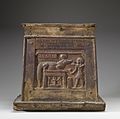Sobek facts for kids
Quick facts for kids Sobek |
|
|---|---|
 |
|
| Major cult center | Crocodilopolis, Faiyum, Kom Ombo |
| Symbol | crocodile |
| Consort | Renenutet or Meskhenet |
| Parents | Set/Khnum and Neith |
Sobek was an important ancient Egyptian god. He was known as the god of the Nile River. People often saw him with the head of a crocodile. To honor Sobek, some temples even kept live crocodiles in special pools.
Contents
Understanding Sobek's Role
Sobek was worshipped in places where the Nile River caused problems. He was seen as the god of crocodiles and controlled the waters. People believed Sobek protected the pharaoh, the ruler of Egypt. He was very popular in a city called Arsinoe, also known as Crocodilopolis. In this city, he was thought of as the Lord of Faiyum, an area in Egypt.
Famous Myths and Stories
One story tells of a time when Sobek was in the Nile. He saw the body of Osiris, who had been murdered by Seth. Sobek was very hungry and ate part of Osiris's body. As a punishment, his tongue was cut off. This myth explains why crocodiles in Egyptian stories do not have tongues. Another myth says Sobek helped catch the sons of Horus when they were born.
Sobek's Appearance and Worship
Sobek was usually shown as a man with a crocodile head. Sometimes, he appeared as a plain crocodile. Egyptians honored Sobek by mummifying crocodiles. They even treated crocodiles like pets, decorating them with jewelry. Temples kept sacred crocodiles because they believed these animals were living images of Sobek on Earth. People thought that if they fed these sacred crocodiles and the crocodiles accepted the food, they would receive blessings from Sobek.
Sobek's Family and Friends
Sobek was considered a friend of Horus. Sobek's mother, Neith, was thought to be the sister of Isis. Isis was the mother of Horus. This made Sobek the cousin of Horus, which was important because Horus was a major god. In other myths, Sobek was connected to Set. Sometimes, Set was even believed to be Sobek's father.
Images for kids
-
This statue of Sobek was found at Amenemhat III's temple. It shows how much this king honored Sobek. Ashmolean Museum, Oxford.
-
This statue shows Sobek with the head of a falcon. This means Sobek was sometimes combined with the sun god Ra to become Sobek-Re. Walters Art Museum, Baltimore.
-
This carving from the Temple of Kom Ombo shows Sobek with royal items. He holds a staff and wears a special kilt. The ankh symbol means he was a healer, and his crown connects him to the sun god Ra.
-
This old box shows a king giving an offering to Sobek. People think this box was used in such ceremonies. Walters Art Museum, Baltimore.
-
Sovk (Suchus, Cronos, Satrune); by Jean-François Champollion; 1823–1825; Brooklyn Museum (New York City)
-
Sobek in his crocodile form; 1991-1802 BCE; Staatliche Sammlung für Ägyptische Kunst (Munich, Germany)
-
Mummified crocodiles of different ages, honoring Sobek; Crocodile Museum (Aswan, Egypt)
-
Statue of Sobek and Amenhotep III; 1550-1292 BCE; calcite; Luxor Museum (Luxor, Egypt)
-
Plaque with a priest and the crocodile-headed god Sobek; 400-30 BCE; limestone; height: 27.5 cm, width: 25.5 cm; Metropolitan Museum of Art (New York City)
-
Amulet of Soknopaios; 305-31 BCE; green faience; 2.7 x 7.9 cm; Los Angeles County Museum of Art (Los Angeles, California)
See also
 In Spanish: Sobek para niños
In Spanish: Sobek para niños














